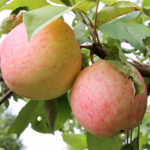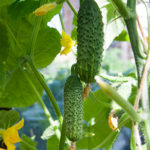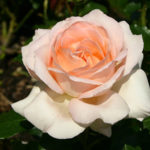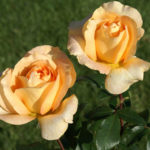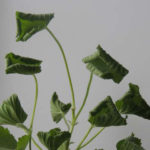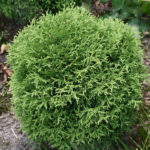Hydrangea paniculata Pinky Winky
Most people prefer to start perennials on their personal plot. Their motive is clear: such crops bloom every year. In addition, the more decorative a perennial plant is, the more fans it has. Certainly not deprived of attention is the variety of Pinky Winky panicle hydrangea, recognized as one of the best varieties of this flower.
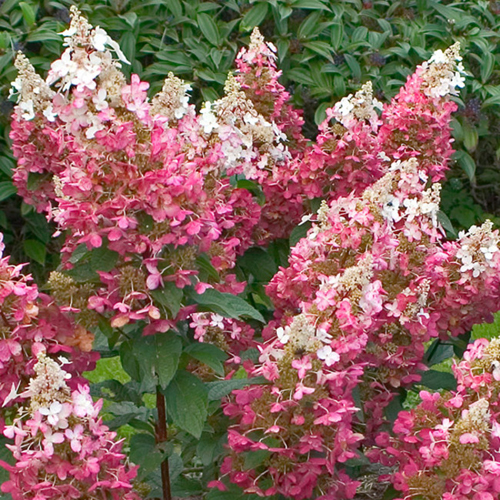
History of creation and description of appearance
Pinky Winky was introduced by Belgian breeders relatively recently - in 2003. But he has already managed to win the love of European flower growers. And all thanks to the magnificent image that the ornamental plant acquires during the flowering phase. Just imagine: on a powerful bush with elastic, strong, slightly fleecy shoots of a ruby shade, long cone-shaped snow-white inflorescences are formed, very reminiscent of flower chestnut candles. It is worth noting that in the future, namely closer to autumn, they change their color to purple-pink. This transition occurs gradually, therefore, on one inflorescence, you can simultaneously see the presence of all the above shades. Moreover, as a rule, the top turns pink last, remaining white for a long time, but the lower part amazes with the splendor of pink-purple tones. This contrast makes the hydrangea very effective. However, Pinkie Winky looks adorable anyway.
The length of the inflorescence is 25-30 cm. It is formed mainly by sterile flowers about 3 cm in diameter. The flowering of the shrub begins in the middle of summer. You can admire the beautiful white-pink panicles without interruption until the October frost. By the way, at the end of the flowering phase, the inflorescences of the culture are painted in a greenish tint. At this stage, they need to be cut to allow new flower panicles to appear.
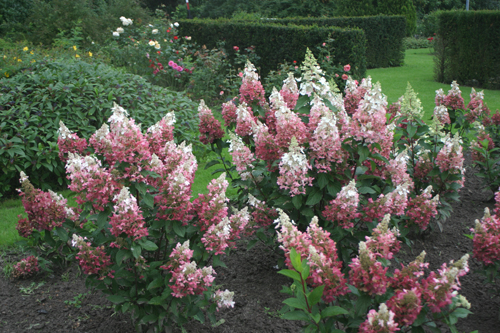
The shrub is a vigorous plant with a broadly rounded crown. Its height, like its width, is 1.5-2 meters. Flexible straight shoots increase in length by 30 cm annually and do not bend under the weight of massive inflorescences. Hydrangea and support with tying are not required, since it keeps its shape well, does not fall apart. On the shoots, large oval leaves develop with pubescence on the outside. They have a dark green color, pointed tips, a rough surface, jagged edges and lack a glossy sheen. In the fall, Pinky Winky's foliage turns reddish, which gives a special charm to the noble culture. An interesting fact: this variety can be grown on a trunk, in the form of a neat tree.
The plant is quite winter hardy. It can withstand a drop in air temperature down to -25 ° C. This quality improves as the culture grows: old specimens and frost above -30 ° C will not harm. The variety is rarely affected by pests and diseases. He lives on average 25-30 years, but under favorable conditions the plant can exist for more than half a century.
Other names of the culture: Hydrangea white-red, Hydrangea two-color.
Agrotechnical features
Pinky Winky can hardly be called capricious, however, it does not differ in unpretentiousness either. It is important to strictly adhere to all the recommendations below for its good growth and lush flowering.
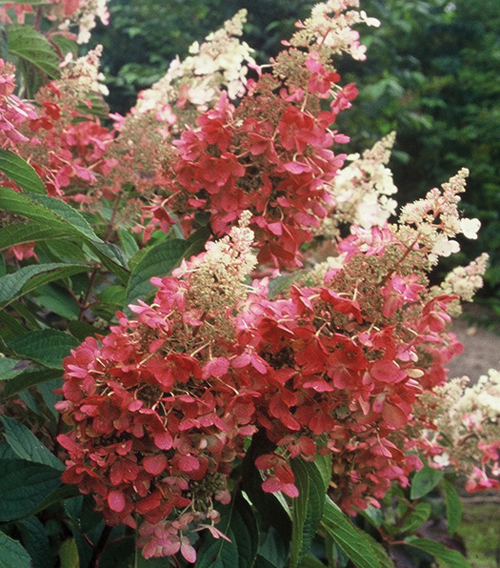
To plant Pinkie Winky, choose an open, well-lit area. Penumbra should be present on the site with a plant only from 11.00 am to 14.00 pm. If this condition is met, you will protect the leaves and flowers from burns, thereby preserving the decorative appearance of the perennial. Adequate amount of light will ensure the beauty's lush and long-lasting flowering. Also, make sure that the culture is not annoyed by drafts and gusty winds.
As a soil for this variety, use a light, loose podzolic soil with an acid reaction (pH 4.5 - 5.5) and a high level of fertility. The plant is planted in early spring or autumn, in the first half of October. The seedling is deepened into the ground by 50 cm.A mixture of humus, peat, fallen needles and sand is placed at the bottom of the planting hole. It will not be superfluous to add mineral fertilizers there. Alkaline and neutral soils, as well as sandy soil, are categorically unsuitable for the plant.
Hydrangea is a moisture-loving crop, and Pinky Winky is no exception to this rule. He needs abundant soil moisture in the root zone. Watering is done at intervals of 1-2 times a week in the summer, and twice a month in spring and autumn. Up to 20 liters of water is poured under the bush at a time.
After each watering, the soil under the flower is loosened and mulched. Need culture and feeding. For good growth and development, organic fertilizer is applied to the soil in the spring, in the summer at the stage of budding and during flowering - a mineral complex.
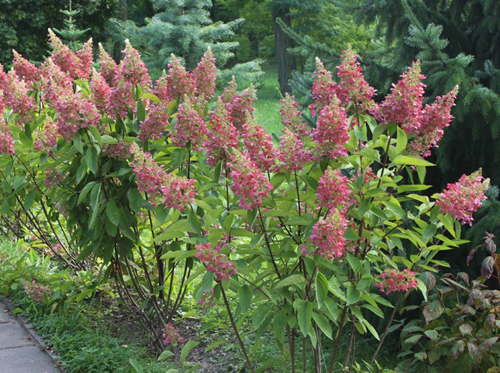
For this variety, pruning is mandatory. First, you need to remove faded paniculate inflorescences in time. Secondly, with the arrival of spring, dry and weak shoots are removed from the plant, and strong stems are cut to several pairs of buds. Mature shrubs rejuvenate with pruning. This event also affects the quality and quantity of hydrangea inflorescences. Cutting Pinky Winky short can end up with larger, fuller panicles, but in small numbers, and vice versa, gentle pruning stimulates the appearance of many small flower cones.
It is very advisable to cover young specimens for the winter, for which the trunk circle needs to be mulched with straw and fallen leaves, and then, bending the stems to the ground, cover it with spruce branches on top. If winters are too harsh in your area, then cut off the shrub, cover it with peat and cover it with foil.
Sometimes Pinky Winky is attacked by aphids. In order to avoid the appearance of this pest on the plant, carry out preventive treatment with a special preparation. To reduce the risk of powdery mildew, spray the hydrangea with a fungicide solution. The variety may be threatened by chlorosis. They get rid of it by using potassium nitrate.
Use cases
Pinky Winky is an ideal solution for landscaping parks, squares, gardens, and personal plots. The flowering shrub enlivens the seating area, gives it unique features, and makes the yard cozy. The variety is often used in landscape design as an accent plant. It is suitable for placement near the gazebo to form a hedge. The flower can be planted on the banks of a decorative pond.
The shrub is good in group compositions, especially if the company is accompanied by other types of panicle hydrangea with a contrasting color of inflorescences or smaller herbaceous and decorative-leaved crops that provide a layering effect in garden ensembles. So Pinkie Winky will stand out from their own kind. A good option is to plant an ornamental shrub in splendid isolation. It looks especially advantageous against the background of a green lawn. You will never get tired of admiring them!
